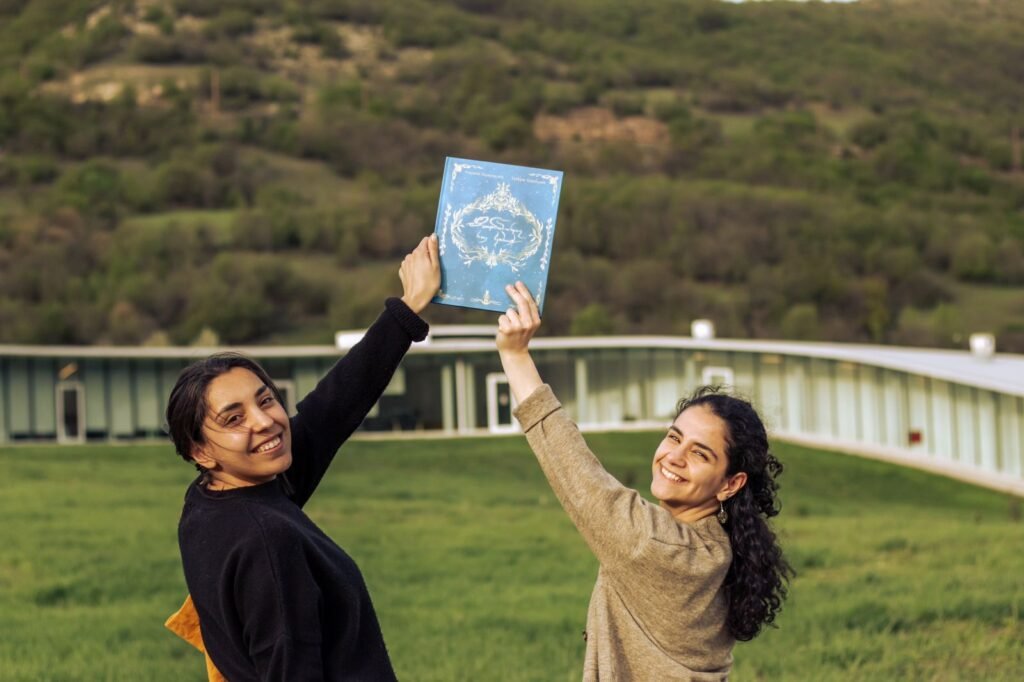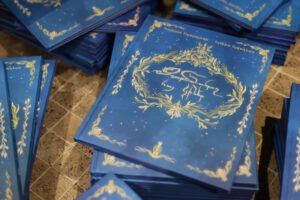 Gayane Aghabalyan and Elmira Ayvazyan are rewriting Armenian history, from the women’s perspective.
Gayane Aghabalyan and Elmira Ayvazyan are rewriting Armenian history, from the women’s perspective.
Aghabalyan and Ayvazyan are the authors of Armenian Wonderwomen, a children’s book that features the biographies of 38 Armenian women whose careers and achievements defied social limitations imposed by gender. The young authors from Armenia are on a mission to pay tribute to women excluded from canonical history and establish their rightful place in Armenian collective memory.
Aghabalyan and Ayvazyan first bonded over their shared rage. They met in 2014 during an exchange program in the United States for youth from Eurasia. They were reunited as undergraduate students at the American University in Armenia, where they would meet for lunch every day and talk about social justice issues. During their passionate lunchtime exchanges, they brought up Armenian women from history who they learned about in their classes, names like Zabel Yesayan and Diana Apkar. They would ask each other, did you know this woman existed?
“For some reason they were ignored,” Aghabalyan told the Weekly. “There was either a deliberate choice to remove them from history, or we are so patriarchal that we didn’t think that what they’ve done is worth talking about.”
In 2019, Aghabalyan and Ayvazyan embarked on a four-year endeavor to recover the names and stories of Armenian women whose accomplishments have been forgotten. With support from the Calouste Gulbenkian Foundation, they dug through archives, read literature and social commentary by these women, and tracked down and interviewed their relatives. Celebrated scholars Dr. Hourig Attarian and Dr. Melissa Bilal served as research advisors and fact-checked their findings.
This laborious research process provoked both surprise and anger—surprise at the unending list of names they unearthed, and anger that so many women had been erased from history.
“The question we asked ourselves was, who else? Who else is there? Who else has been there that we don’t know about?” Aghabalyan said.
 Armenian Wonderwomen features women who transgressed gender norms throughout their lives. Louisette Texier was a “wildcard,” in Ayvazyan’s words. Texier was a survivor of the Armenian Genocide whose father was killed by Turkish officers. She was separated from her mother and sister and wound up alone in an orphanage in France. Texier fled from the orphanage to become a cabaret dancer. She later worked as a seamstress and developed a lifelong passion for race car driving. “You had to be brave and fearless to drive in those days,” Texier said in an interview. Her male competitors were so threatened by her talent that they would fill her trunk with heavy objects to slow down her car.
Armenian Wonderwomen features women who transgressed gender norms throughout their lives. Louisette Texier was a “wildcard,” in Ayvazyan’s words. Texier was a survivor of the Armenian Genocide whose father was killed by Turkish officers. She was separated from her mother and sister and wound up alone in an orphanage in France. Texier fled from the orphanage to become a cabaret dancer. She later worked as a seamstress and developed a lifelong passion for race car driving. “You had to be brave and fearless to drive in those days,” Texier said in an interview. Her male competitors were so threatened by her talent that they would fill her trunk with heavy objects to slow down her car.
The authors also rediscovered renowned figures, such as fedayee fighter Sose Mayrig. They were familiar with narratives about Sose Mayrig as a motherly figure who cared for her husband and young soldiers as a nurse. In the course of their research, they discovered that the fedayee continued battling Turkish forces after the deaths of her husband and two sons. Sose Mayrig was a mother, but she was also a fierce, indefatigable fighter.
“It goes for all the women. Some we don’t know. Some we know very little about, and the little that we know is centered on the men in their lives,” Aghabalyan said.
The book not only centers the achievements of women in Armenian history, but also corrects another historical erasure. While conducting their research, the authors found that these women’s stories were inextricable from the social justice issues they advanced, including workers’ rights, education, environmentalism and social equality.
Ayvazyan said these issues are not widely discussed in Armenia.
“For someone who graduated from Armenian school, I see it as a big educational gap. I wish I had the opportunity to learn about these topics. Learning about it through these women and seeing what contribution they had even 100 years ago is fascinating. Sometimes it feels like we forgot about a big heritage we could have used to evolve,” Ayvazyan said.
Ayvazyan and Aghabalyan are presenting a retelling of Armenian history in which Armenian women have long defended social justice causes. Aghabalyan agreed with her co-author that the women in their book represent Armenian history and tradition.
“That’s the tradition we want to claim and belong to, not the superficial things that are made up and thrown at our faces every step of the day, stating this is not our tradition, not our history,” Aghabalyan said.
Armenian Wonderwomen features vivid illustrations by Noosh Petrosyan and Artsrun Ganjalyan. It is available for purchase in both Eastern and Western Armenian through online orders.



Be the first to comment